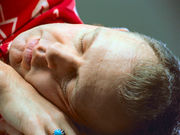Change in Functional Outcome of Sleep Questionnaire at four months noninferior for level 3, 4 versus 1
FRIDAY, Jan. 27, 2017 (HealthDay News) — For patients with suspected obstructive sleep apnea (OSA), use of level 3 (L3) polysomnography (PSG) data with fewer recording channels is noninferior to level 1 (L1) PSG, according to a study published online Jan. 24 in the Annals of Internal Medicine.
Ching Li Chai-Coetzer, M.B.B.S., Ph.D., from Flinders University in Adelaide, Australia, and colleagues compared patient outcomes after PSG versus limited-channel studies in a randomized noninferiority study involving patients with suspected OSA. Sleep study information disclosed to sleep physicians included L1 PSG data (135 patients), L3 data (airflow, thoracoabdominal bands, body position, electrocardiography, and oxygen saturation; 136 patients), or level 4 (L4) data (oxygen saturation and heart rate; 135 patients).
The researchers found that the change in Functional Outcomes of Sleep Questionnaire score was not inferior for L3 or L4 versus L1 (mean difference [MD], 0.01 [95 percent confidence interval, −0.47 to 0.49; P = 0.96] and −0.46 [95 percent confidence interval, −0.94 to 0.02; P = 0.058], respectively; noninferiority margin [NIM], −1.0). Change in Epworth Sleepiness Scale score was not inferior for L3 versus L1 (MD, 0.08; 95 percent confidence interval, −0.98 to 1.13; P = 0.89), but was inconclusive for L4 versus L1 (MD, 1.30; 95 percent confidence interval, 0.26 to 2.35; P = 0.015) (NIM, 2.0). There was less improvement in the Sleep Apnea Symptoms Questionnaire (P = 0.018), less continuous positive airway pressure use (P = 0.04), and lower physician diagnostic confidence for L4 versus L1 (P = 0.003).
“The results support manually scored L3 testing in routine practice,” the authors write. “Poorer outcomes with L4 testing may relate, in part, to reduced physician confidence.”
Several authors disclosed financial ties to the pharmaceutical and medical technology industries.
Full Text (subscription or payment may be required)
Editorial (subscription or payment may be required)
Copyright © 2017 HealthDay. All rights reserved.








